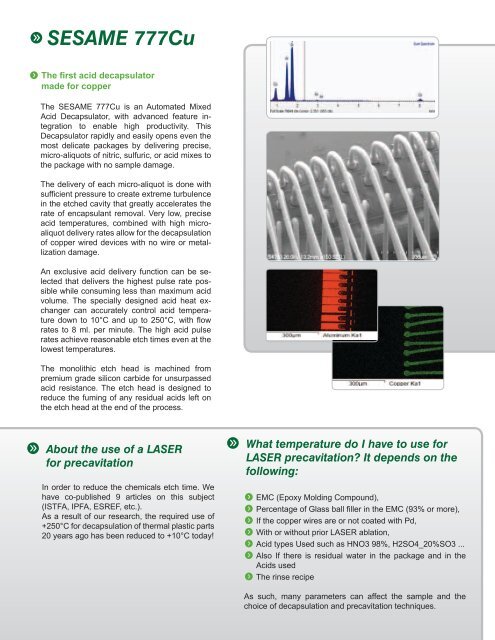g Sesame 707 / 777Cu
g Sesame 707 / 777Cu
g Sesame 707 / 777Cu
You also want an ePaper? Increase the reach of your titles
YUMPU automatically turns print PDFs into web optimized ePapers that Google loves.
g SESAME <strong>777Cu</strong><br />
f the first acid decapsulator<br />
made for copper<br />
g<br />
The SESAME <strong>777Cu</strong> is an Automated Mixed<br />
Acid Decapsulator, with advanced feature integration<br />
to enable high productivity. This<br />
Decapsulator rapidly and easily opens even the<br />
most delicate packages by delivering precise,<br />
micro-aliquots of nitric, sulfuric, or acid mixes to<br />
the package with no sample damage.<br />
The delivery of each micro-aliquot is done with<br />
sufficient pressure to create extreme turbulence<br />
in the etched cavity that greatly accelerates the<br />
rate of encapsulant removal. Very low, precise<br />
acid temperatures, combined with high microaliquot<br />
delivery rates allow for the decapsulation<br />
of copper wired devices with no wire or metallization<br />
damage.<br />
An exclusive acid delivery function can be selected<br />
that delivers the highest pulse rate possible<br />
while consuming less than maximum acid<br />
volume. The specially designed acid heat exchanger<br />
can accurately control acid temperature<br />
down to 10°C and up to 250°C, with flow<br />
rates to 8 ml. per minute. The high acid pulse<br />
rates achieve reasonable etch times even at the<br />
lowest temperatures.<br />
The monolithic etch head is machined from<br />
premium grade silicon carbide for unsurpassed<br />
acid resistance. The etch head is designed to<br />
reduce the fuming of any residual acids left on<br />
the etch head at the end of the process.<br />
About the use of a LASER<br />
for precavitation<br />
In order to reduce the chemicals etch time. We<br />
have co-published 9 articles on this subject<br />
(ISTFA, IPFA, ESREF, etc.).<br />
As a result of our research, the required use of<br />
+250°C for decapsulation of thermal plastic parts<br />
20 years ago has been reduced to +10°C today!<br />
g<br />
What temperature do I have to use for<br />
LASER precavitation? It depends on the<br />
following:<br />
f EMC (Epoxy Molding Compound),<br />
f Percentage of Glass ball filler in the EMC (93% or more),<br />
f If the copper wires are or not coated with Pd,<br />
f With or without prior LASER ablation,<br />
f Acid types Used such as HNO3 98%, H2SO4_20%SO3 ...<br />
f Also If there is residual water in the package and in the<br />
Acids used<br />
f The rinse recipe<br />
As such, many parameters can affect the sample and the<br />
choice of decapsulation and precavitation techniques.


